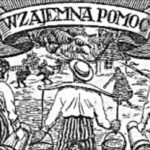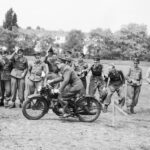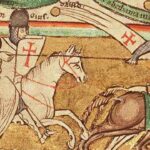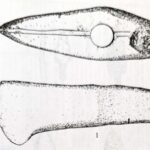The goddess Venus, money and women of the Severans
In the presented article, Anita Smyk analyzes the iconographic and ideological aspects of coins issued by women from the Roman Severan dynasty, on the reverse of which the goddess Venus Felix is depicted. This allowed the author to determine the role of this Roman goddess in the self-presentation of women of the ruling family. Go to the article.
Communist crime in the “Baran” forest in the Radzyń Podlaski district
At the turn of 1944 and 1945, in the “Baran” forest in Kąkolewnica in the Radzyń Podlaski district, the Court of the 2nd Army of the “People’s” Polish Army murdered soldiers of the Polish independence underground. The locals called this place “Little Katyn” due to the method of eliminating victims, similar to Katyn, i.e. shooting in the back of the head, tied hands and mass burials. This article is the first attempt to scientifically describe these crimes. We invite you to read.
Co-operatives traditions of Łomża
We invite you to read the study by prof. Zofia Chyry-Rolicz on cooperatives in Łomża, covering the period from the end of the 19th century to the end of the 20th century. Go to the article.
An intellectual from the Polish People’s Army
After World War II, the communists ruling Poland sought to replace the elites through the extermination and social degradation of temporary and social advancement of their supporters. Its part was to consist of officers of the new, “people’s” Polish Army. Paweł Orłowski’s article describes the ideology of creating officer cadres in the Polish People’s Republic. Go to the article.
Exegesis of the biography of Zbigniew Braun
In the fall of 1947, Zbigniew Braun, a Home Army soldier from Radzyń Podlaski, a Warsaw insurgent and a prisoner of the German Stalag, returned to the country under communist rule. Summoned to the District Command of the Polish People’s Army in Biała Podlaska, he submitted his own biography in which he described his fate during World War II. Piotr Gorzelańczyk subjected this document to a critical historical analysis. We invite you to read.
Templars in Łuków
Was there a Templar commandery in Łuków? If so, where did they come from and how were they organized? This problem, in the light of Pope Alexander IV’s bull of 1257, is discussed by Marcin Gomółka in his article.
Archaeological sites in Siedlce region
Archaeological sites in the vicinity of the city of Siedlce allow you to observe the history of settlement in this area from the late Paleolithic to the Middle Ages. Its outline covering the area of the present Siedlce poviat is presented in an article by Marta Czerwaniec-Ivasyk. We invite you to read: https://doi.org/10.36121/RRH.21.2023.6
German labor camps for Jews in the district of Radzyń
During World War II, 20 German labor camps for Jews were located in the Radzyń county. People who were not adapted to hard conditions, without appropriate tools and clothing, were sent to work. A serious problem was the lack of food. As a consequence, this led to frequent cases of starvation, epidemics and diseases. These facilities served not so much German economic purposes as extermination. Labor camps and other places of forced labor became places of gradual destruction of the people there.
Sławomir Mańko discusses this issue in his article. We invite you to read: https://doi.org/10.36121/RRH.21.2023.5
Index of the notary public of the Łosice poviat 1810-1812
We invite you to use the alphabetical index of the notary Szymon Czarnocki in Łosice from the years 1810-1812. It was prepared as part of the substitute professional practice of students of History at the University of Natural Sciences and Humanities in Siedlce during the lockdown in 2020-2021. Go to the article
Defenders of the faith of the Uniate rite from Dołhobrody
As a result of the actions of the Russian authorities, in 1874 Dołhobrody had to leave the last Uniate priest, Leon Horoszewicz. Thirty years later, the Uniate Andrzej Błyskosz also left the parish and went on a pilgrimage to Pope Pius X. His goal was to deliver a petition against the persecution of the Uniates by the Russians.
We invite you to read the article by Mateusz Sarnacki devoted to these two outstanding Uniates.







